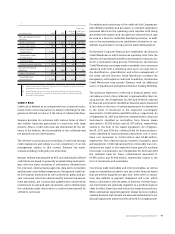Siemens 2015 Annual Report Download - page 98
Download and view the complete annual report
Please find page 98 of the 2015 Siemens annual report below. You can navigate through the pages in the report by either clicking on the pages listed below, or by using the keyword search tool below to find specific information within the annual report.Consolidated Financial Statements
As of September , and the VaR relating to foreign
currency exchange rates was € million and € million. This
VaR was calculated under consideration of items of the Consol-
idated Statement of Financial Position in addition to firm com-
mitments which are denominated in foreign currencies, as well
as foreign currency denominated cash flows from forecast
transactions for the following twelve months. A higher volatil-
ity between the U. S. dollar and the euro in comparison to prior
year resulted in an increase of the VaR. Furthermore, the VaR
was influenced by changes to hedging level and hedging hori-
zon with regard to foreign currency denominated cash flows
from forecast transactions.
Translation risk
Many Siemens units are located outside the euro zone. Since
the financial reporting currency of Siemens is the euro, the fi-
nancial statements of these subsidiaries are translated into
euro for the preparation of the Consolidated Financial State-
ments. To consider the effects of foreign currency translation in
the risk management, the general assumption is that invest-
ments in foreign-based operations are permanent and that re-
investment is continuous. Effects from foreign currency ex-
change rate fluctuations on the translation of net asset
amounts into euro are reflected in the Company’s consolidated
equity position.
INTEREST RATE RISK
Interest rate risk is the risk that the fair value or future cash
flows of a financial instrument will fluctuate because of changes
in market interest rates. This risk arises whenever interest terms
of financial assets and liabilities are different. In order to man-
age the Company’s position with regard to interest rate risk, in-
terest income and interest expenses, Corporate Treasury per-
forms a comprehensive corporate interest rate risk management
by using fixed or variable interest rates from bond issuances
and derivative financial instruments when appropriate. The in-
terest rate risk relating to the Group, excluding SFS’ business, is
mitigated by managing interest rate risk actively relatively to a
benchmark. The interest rate risk relating to the SFS’ business is
managed separately, considering the term structure of SFS’s fi-
nancial assets and liabilities. The Company’s interest rate risk
results primarily from the funding in U. S. dollar, GBP and euro.
If there are no conflicting country-specific regulations, all
Siemens operating units generally obtain any required financ-
ing through Corporate Treasury in the form of loans or inter-
company clearing accounts. The same concept is adopted for
deposits of cash generated by the units.
As of September , and the VaR relating to the inter-
est rate was € million and € million. In fiscal the
interest VaR mainly increased due to the issuance of fixed-rate
US$ bonds and higher interest rate volatilities for EUR and US$.
The issuance of fixed-rate U. S. dollar bonds locked in a fixed
rate and thus avoided additional cash flow risk.
EQUITY PRICE RISK
Siemens’ investment portfolio consists of direct and indirect
investments in publicly traded companies held for purposes
other than trading. The direct participations result mainly from
strategic partnerships, strengthening Siemens’ focus on its
core business activities or compensation from merger and ac-
quisitions transactions; indirect investments in fund shares are
mainly transacted for financial reasons.
These investments are monitored based on their current mar-
ket value, affected primarily by fluctuations in the volatile tech-
nology-related markets worldwide. As of September ,
and the market value of Siemens’ portfolio in publicly
traded companies was € , million compared to € , mil-
lion in the prior year. The increase is due mainly to higher mar-
ket values of our stakes in OSRAM and AtoS.
As of September , and , the VaR relating to the eq-
uity price was € and € million. The increase is due
mainly to higher market values related to the above-mentioned
stakes and an increased volatility.
LIQUIDITY RISK
Liquidity risk results from the Company’s inability to meet its
financial liabilities. Siemens follows a deliberated financing
policy that is aimed towards a balanced financing portfolio, a
diversified maturity profile and a comfortable liquidity cushion.
Siemens mitigates liquidity risk by the implementation of an
effective working capital and cash management, arranged
credit facilities with highly rated financial institutions, via a
debt issuance program and via a global multi-currency com-
mercial paper program. Liquidity risk may also be mitigated by
the Siemens Bank GmbH, which increases the flexibility of de-
positing cash or refinancing.
In addition, Siemens constantly monitors funding options
available in the capital markets, as well as trends in the avail-
ability and costs of such funding, with a view to maintaining
financial flexibility and limiting repayment risks.
The following table reflects the contractually fixed pay-offs for
settlement, repayments and interest. The disclosed expected
undiscounted net cash outflows from derivative financial liabil-
ities are determined based on each particular settlement date
of an instrument and based on the earliest date on which
Siemens could be required to pay. Cash outflows for financial
liabilities (including interest) without fixed amount or timing
are based on the conditions existing at September , .
























